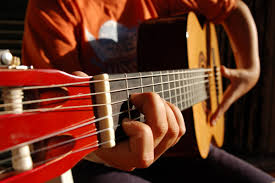

10 razones. 2
24/12/2019
My experience as a teacher has been nurtured by different profiles of students, some of them left-handed, and I have always tried to be as comprehensive with their uncertainties and difficulties, avoiding giving a closed answer about the type of guitar or position in which they should place their instruments (whether as right-handed or left-handed), but whenever they ask me for advice I rely on the points indicated above, in addition to indicating the progress and evolution of other left-handed students to whom I have taught.
I have noticed on several occasions, as left-handed guitar students who played with the standard position (such as right-handed), they were more skilled when it came to placing chord positions and performing technical exercises, either interpreting scales or playing melodies, that many right-handed students. This could be easily understood, understanding that in the left hand greater coordination is required that involves striving to place the fingers on different frets between the six strings that the guitar has, in addition to the multiple combinations of chords that we can find, multiplying everything this is the difficulty involved in the correct use of the left hand, while when we begin to learn strumming, the right hand should only focus on strumming the strings with some precision in repetitive movements, trying to respect the musical pulse, the latter also related to single string beats to perform melodies. To understand this, and by way of example, if you play the guitar or have you ever taught, or simply if you were ever in guitar lessons, when a student starts studying chords and tries to play a song, his procedure is the following:
1. Place the position of the first chord
2. Strum with the rhythm of the song
3. For the rhythm until the second chord is placed
4. And once you have placed the second chord proceed to interpret the rhythm that accompanies it.
According to this process, where is the difficulty? In the rhythm or in the position of the chord? Some argue that the guitar is an instrument for left-handed people, since especially when we start, the greatest difficulty is related to the use of the left hand, although as we increase the difficulty of the pieces to be interpreted, or the different technical exercises , the difficulty is extrapolated to either hand, as in most instruments.
In the strictest academic training, that of the Conservatories, there are no distinctions between left-handed or right-handed people when it comes to musical learning (at least in most cases) and the example we have watching the orchestras, why all violins, violas, cello or double basses are placed in the same position? Are there no left-handed violinists? The answer, of course, is that there are left-handed violinists, but everyone learns to play in the same position, and it will be necessary to see if playing with a right-handed position really impacts negatively on their abilities, speed or interpretive quality. In addition, we could talk about that there are no left-handed pianos, if we had to follow a logic to the inverse manual ability, since if the right most skilled hand is the one that should be used for the melodies, mostly located in the Acute frequencies (I say this because they usually tend to have a higher speed than the accompaniment vocals), why haven't they reversed the position of the notes and octaves for left-handers on pianos?
With this article I do not want left-handers to be forced to learn to play in the standard position, but if they take into account these points that could help avoid having future headaches, since many times our approach is usually short term , and over time we can have a different approach and regret a bad decision in our beginning. Even so, it should be added that in some cases a beginner may look more comfortable in the left-handed position, but this can happen even to the right-handed, but comfort is a factor among many, and should not be the only one to consider , it may be much better to sacrifice some comfort in the early stages of learning, until we adapt to the correct position. If not, see a very typical case in beginners, especially in children, when trying to convey the importance of each finger of the left hand being responsible for a different fret (finger 1 fret 1, finger 2 fret 2, ...) and they will tell you while they move their finger 1 for any fret that is that they feel more comfortable like this and that it is easier for them, would you let this student learn using a single finger because it feels more like that?
Guitarists who endorse playing as right handed being left handed:
• Gary Moore
• Mark Knopfler
• Juanjo Domínguez
• ...
If you decide to play in position 1, you will have everything in your favor, since 99.9% of the instruments and materials are designed for this placement. If you decide position 2 you will see difficulty in adaptation or perspective with which you must face when reading diagrams, tabs, and placing chord positions among others. If you decide on the third option, you will be very limited in terms of guitar models and still need to adapt to existing materials.
You can always think, I can buy a right-handed guitar, change the position and change the strings in reverse, but this has associated other complications, such as if the guitar can be hung with a shoulder strap (strap) the anchors of this they will be underneath and you will not be able to hang the guitar unless you place new anchor points. And if you change the order of the strings (the 1st where the 6th goes ...) the bridges should be modified and adapted, since they are usually compensated, if you will not lose quality in the tuning and you could even endanger the life of the bridge of your guitar.
I would like to know your opinion and that you add a comment giving your point of view or experience, it could be very enriching and help many beginners.















